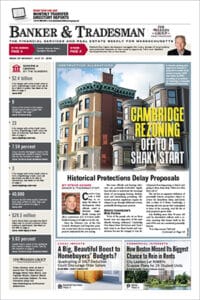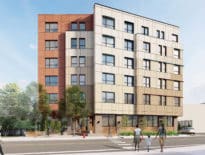
Cambridge and San Francisco saw housing construction drop off dramatically after both raised affordability requirements in recent years.
Boston Mayor Michelle Wu has rolled the dice on maybe one of the biggest gambles she’ll take in office.
The Wu administration said Dec. 15 it is now planning to hike the number of apartments or condominiums that developers are required to rent or sell at below-market rates in nearly every new residential building they put up by more than 40 percent.
The impulse behind the move is certainly understandable, with rents in Boston at sky-high levels. And it is likely to be a crowd-pleaser as well for some of the new mayor’s most fervent supporters, who are more likely than not to brush off concerns the real estate sector has raised about the idea’s financial feasibility.
However, developers are pushing back, arguing additional requirements will increase the cost to build at the same time that construction costs have gone through the roof and banks and other lenders are getting cold feet.
One top development executive, noting he had just come back from a holiday party filled with real estate and businesspeople, indicated the Wu administration has a tough hill to climb selling the new requirements.
“The talk in the room was how tone-deaf this administration is at a tough time in the market when they should be doing everything possible to stimulate development,” he said. “Hello, suburbs!”
And while city officials have worked overtime to downplay concerns the increase might lead to a drop in housing production, the experience of similar maneuvers in Cambridge and San Francisco suggests that is just what may happen.
Cambridge’s Cautionary Tale
In fact, the evidence comes right from one of the consultants Boston hired to research the potential impact of a hike in the city’s affordable housing requirements.
Cambridge began requiring 20 percent of units in all new housing projects built in the city to be designated affordable starting in 2017. Over the next five years, the overall number of new residential units built across the Charles fell by a whopping one-third, according to the report by RKG, the consultant in question.
That said, the number of affordable units did increase in Cambridge – by all of 2 percent.
Overall, roughly 1,000 fewer apartments and condos were built in the People’s Republic over the past five years since the city boosted its affordability requirements, than over the five years before that. In the middle of a dire housing crisis, that’s a lot of housing lost.
“If you have heard about the fable of the golden goose, at some point you squeeze too hard,” said David Begelfer, principal at CRE Strategic Advisors. “It’s a pretty fragile market. Adding on costs substantially could be a real problem.”
A similar thing happened on the West Coast. San Francisco began requiring developers to boost the number of affordable units in their projects to 25 percent in 2016. Construction dropped off markedly, falling from 1,800 to 2,000 new affordable units a year to less than 1,000.
While 1,500 affordable units came online in the San Francisco last year, it was still significantly below what it had been before.
Tax Abatements Possible
For his part, Arthur Jemison, the city’s chief planner and director of the Boston Planning & Development Agency, said he and other city officials have heard the concerns of the development industry and are doing everything they can to offset any additional costs.
Under the new standard, housing developers must offer a fifth of the units in any new project at below-market rates. That’s up from 13 percent before.
But Jemison contends the new housing proposals that are now coming before the city for approval are already close to meeting the new 20 percent affordable requirements, with the number of affordable units averaging 17 percent.
The remaining 3 percent of the units needed to get to that 20 percent mark under Wu’s plan would be covered by tenants paying market rents with federal housing vouchers, taking developers off the hook for the cost, city officials say.
For proposed projects that go above and beyond meeting various goals set by the city, there is also the possibility of tax abatement agreements, Jemison said.
And Jemison and other city officials are looking at ways of streamlining the project review process and reducing the amount of time developers have to spend pitching their plans at City Hall.
Jemison said he reached out to as many as 20 different top developers in the city to tap their thoughts.
“We are keenly aware of the environment we are working in right now and the uncertainty,” Jemison said.

Scott Van Voorhis
Will Some Developers Pull Back?
Sheila Dillon, the city’s housing chief, said she and other officials have worked on the affordable housing proposals for months, looking to minimize any impact on developers and keep the construction of new housing moving forward.
“Housing production is very important for us,” Dillon said. “It’s top of mind.”
Yet while the reassurances offered by Jemison and Dillon certainly seem genuine, there are reasons to question how thrilled developers have been with the steady ratcheting up of the number of affordable units they must build.
At least one developer noted he was already well along in the approval process when he learned the goal posts had moved for his project from 13 percent affordable to 17 percent.
So, the real test here will be what developers who have not yet begun the permitting process or are in the early stages do, and whether some start to pull back.
And we won’t know the answer to that for a while. That said, the data from Cambridge and San Francisco suggests there are reasons to be concerned that the bold move by Boston’s new mayor could backfire.
Scott Van Voorhis is Banker & Tradesman’s columnist; opinions expressed are his own. He may be reached at sbvanvoorhis@hotmail.com.






